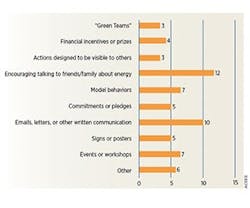Why Do Tenant Programs Fail to Deliver Efficiency?
Engaging tenants can boost efficiency, but if you’re relying on fliers, the information is likely flying in one ear and out the other.
While it’s important to encourage people in multifamily properties to change their behavior and reach goals, it takes more than just a poster to affect such change, notes the American Council for an Energy-Efficient Economy (ACEEE).
In a recent report, Saving Energy with Neighborly Behavior: Energy Efficiency for Multifamily Renters and Homebuyers, the council assesses key features of existing programs and makes recommendations for improvements that property owners and managers can implement immediately.
ACEEE found that tenant engagement programs are much more likely to be found in properties with primarily low-income residents where motivation to save money is high. The programs also rely heavily on mass information campaigns, such as posters, a technique that ACEEE has found to be largely ineffective.
Incentives, challenges, and teams with peer role models are more complex and successful behavioral techniques, ACEEE observes. The group recommends using community-based social marketing (CBSM) to take the next step and tailor programs to a targeted community.
About 70% of the programs included cognitive and social interaction elements like conveying information about energy efficiency and encouraging respondents to discuss ideas with friends, family, and other tenants. Prizes or financial incentives were much less common at 30%. They included raffles, rent reductions, and other rewards.
ACEEE’s engagement efforts follow their 2010 report that looked at more than 60 studies on giving feedback to residential customers on their energy use, comparing their consumption to others, and offering them strategies to save energy. Typical savings were 4-12%.
These strategies appeal to program administrators because they offer a good bang for their buck. Because these campaigns are relatively inexpensive compared to capital improvements, they are attractive to managers and owners with low funding.
ACEEE recommends that to build more programs like these, there is need for more utility involvement and better tools and resources for property managers. The full report is available at aceee.org.
